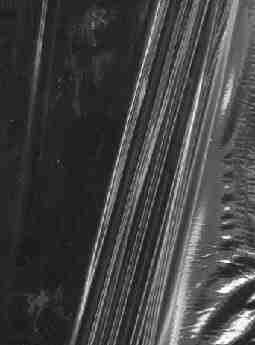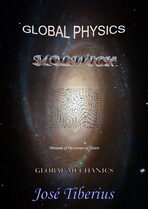1. CONCEPT OF MATTER
1.a) Matter and energy
The theory of Global Physics is an interpretation of Quantum Mechanics and General Relativity. It is a non-relativistic theory, but it incorporates some concepts of the Theory of Relativity. We can cite the Mach principle, the equivalence E = mc² of Olinto de Pretto, the double gravity on the energy –initially formulated by Paul Gerber with the formula of the orbit of Mercury 20 years before Einstein–, and the Lense-Thirring drag effect on electromagnetic energy that allows maintaining the classic time and space.
The development of the new gravity theory has implied changes in many principles and laws of physics, configuring a theory of unification and a theory of everything. We can divide the modified physics principles of the new paradigm into two broad groups:
In the first group, the affected physics principles will define matter in the general sense and its various states of aggregation.
-
In the second one, the physics principles relate to Euclidean space and absolute time and all the implications concerning the properties of matter in its various states of aggregation, such as the concepts of movement, force, gravity force, and energy.
This modern science book studies the first group of principles of physics related to the equivalence of gravity and mass, from its support, constitution, or physical reality, and the energy as a property of the aggregation states of matter.
If Global Dynamics deals with space, time, and their relation to the physics of gravity, Global Mechanics is more concerned with areas closer to Quantum Mechanics.
Contemplating the properties reticular structure of matter or Global Aether, and the subatomic world has led us to create some explanations regarding the states of aggregation of matter, which configure concepts of mass and gravity.
We would like to emphasize two particular aspects. On the one hand, the Global Aether and the mass exist as real physical entities, and independently of any observer. On the other hand, in the new theory of everything forces at a distance or forces derived from fields with mathematical properties without material support of a physical nature are unnecessary.
Even though the complexity of the mathematical formulae, related to the states and the structure of matter studied in Quantum Mechanics, would cause severe mathematical tensions to neurons; this Global Mechanics book on the concept, properties, and characteristics of matter avoids quantitative details to keep the difficulty level as low as possible.
Nevertheless, we believe mathematics will not be a problem when it comes to the new definition of matter and the other unusual ideas. Mathematical tools today are very advanced, but they lack a physical base to support them and make them coherent within a complete model of the physical reality.
Amongst the most innovating elements of Global Mechanics regarding the concept of matter and energy are the following:
-
A new description of the structure of matter
-
The existence of the Global Aether –the reticular structure of matter supporting potential gravitational energy, kinetic energy, and mass–, allows one to understand the origin of the forces of gravity.
-
Clarification of the mechanisms of mechanical energy in the transformation between kinetic energy and gravitational potential energy
The modulations of the force of gravity, which can even become negative; this could mean the confirmation of the equation of the Gigachron experiment.
-
-
Relation of the forces and fields of gravity with the electromagnetic forces and fields
The concept of gravity –tension of the longitudinal curvature of Global Aether– as a medium for the propagation of light
-
Definition of photons as mechanical waves of torsion or transversal turns
The constant speed of light because the light is a physical wave of torsion or transversal turn of a mechanical nature.
-
Variation of the speed of light with changes in the intensity of the gravitational field or LUM Aether (Luminiferous, universal, and mobile)
-
An explanation of the wave-particle duality of light of the photoelectric effect and Young’s experiment or double-slit experiment
-
Unification of the force of gravity with weak and strong nuclear forces, and with the electromagnetic interaction
-
Concept and nature of elementary particles with mass
The new atomic model offers a mechanical rather than virtual base for the Standard Model of fundamental particles; allowing us to understand some of the relationships between said particles without needing to use magic.
The explanation of the dual, and in some cases mixed, nature of matter.
Explication of the tunnel effect
-
Despite its specific nature regarding the matter and its properties, Global Mechanics is a part of the Global Physics, which constitutes at the same time a theory of unification and a theory of multiple interpretations (Quantum Mechanics and Theory of Relativity).
The reinterpretation in the case of the Theory of Relativity is relatively simple because even if it has some significant ideas, like the initial approach on the mass-energy equivalence, its nucleus of the relativity of time is incorrect from a physical point of view and a conventional or formal one.
On the edge of an object

Regarding Quantum Mechanics, the topic is more complex. On the one hand, Quantum Mechanics based on more detailed knowledge, as it limits itself to the Principle of Uncertainty that considers the study of the underlying mechanisms of energy and the knowledge of reality under a certain threshold. This way, it avoids making mistakes about precise concepts, gaining indisputable usefulness in the world of science and technology.
On the other hand, as it starts from a non-relativistic General Physics, Quantum Mechanics has some classical concepts about movement and energy. Therefore, it is more difficult to refute, modify or improve. Nevertheless, some of the interpretations seem to be quite far from physical reality.
In a way, the new paradigm of Global Physics, which will uncover slowly, could mean a scientific leap concerning to Newtonian Physics; similar to the one Classical Physics took apropos Greek Mechanics. Bearing in mind the degree of abstraction needed to understand the new concepts, which are not at all intuitive; it is advisable to grasp the new concepts while reading further.
